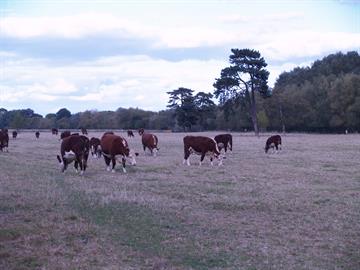Grazing Animals
GRAZING OPTIONS FOR SUSTAINABLE FARMING
The two main methods of grazing management are continuous or rotational.
Continuous Management
Here animals are left in the same paddock throughout the entire growing season (they may be moved elsewhere over winter, or when it is time to sell).
- This works well in areas with dependable climate (e.g. England).
- It is not appropriate when growing conditions are variable (e.g. areas that have spurts of growth, or dry and wet periods).
- It is not suitable in pastures containing a variety of species with different growth rates - some species can be over-grazed, and others under-grazed.
Rotational Grazing
Research has shown that overgrazing is not related so much to the number of animals in a paddock; rather it is affected by the time the animals spend in the paddock.
Rotational grazing is usually preferable for farm sustainability.
- It has sometimes has involved rotating a herd between several paddocks, ignoring the status of pasture in each paddock...sometimes under grazing, sometimes overgrazing.
- This method should be used to minimise over-grazing and under-grazing.

Other Methods
Voisin Grazing Method
Voisin was an academic and scientist in France who devised a grazing method that interferes minimally with the pasture environment.
The concept involves dividing a pasture into small paddocks and rotating animals through them. The rate of rotation is dependent upon growth rate of pasture plants, and the pasture mass.
The aim is to keep plants as close to the peak of their growth curve as possible. Pre and post grazing pasture masses are estimated for each paddock, and this then forms a basis for deciding when to move animals on to the next paddock.
Reference: Sustainable Agriculture in Temperate Climates by Francis et al (Chapter 8)
Publisher: Wiley
Strip Grazing
Problem: when animals are given a greater choice for grazing they can become selective; hence certain plants in the pasture can be eaten out and disappear, while other less-favoured species remain relatively untouched.
Answer: restrict animals to a small area and they become less selective about what they eat, so the area can be grazed more evenly.
During drought or other difficult periods, extra temporary grazing may be found on public land or other sites in your locality.
Roadside Grazing
Roadsides often provide extensive areas of suitable foodstuffs for stock. In areas where remnant vegetation is scarce there may be long stretches of grass suitable for cutting as hay, or for grazing stock on. Grazing such areas has the added advantage of reducing fire risk by reducing fuel loads. It may have a detrimental effect on any small patches of remnant vegetation that may still exist, particularly if the vegetation is very palatable for your stock.
* Control of stock is critical
- They should not impede traffic or create a safety risk (e.g. risk of car accidents).
- They can be controlled by temporary electric fencing, but this should be regularly checked, or by being herded at all times (e.g. by stockmen and dogs).
* It is important to check local regulations regarding roadside grazing. You may require a permit, or it may not be allowed at all. Consider the damage that may be done to the public of vehicles if an accident should occur.
* In some states established droving routes have been gazetted in state legislation. Regulations governing grazing on these reserves should be checked out before contemplating such grazing.
* As with stock on your property, it is very important that stock grazing on roadsides have access to a suitable water supply. Access to such supplies should be controlled to prevent damage to the supply and its surrounds.
Public Land
In some areas it may be possible to obtain permits or leases to graze public land. These may be temporary (e.g. as a means of reducing fire risk) or ongoing. Check with your local Department of Agriculture or Land Management to see if this is possible in your area.
Commercial Timber Plantations
Large pine and hardwood plantations may have areas of grass (e.g. between rows) large enough for grazing. It may be possible to obtain permission from plantation managers/owners to graze these areas. (This practise helps them by reducing fire risk and competition for their trees.)
Council Land
Council approval is needed.
Industrial Areas (around factories)
Consider any approval needed from local council or factory owners. Some factories allow agistment on the surrounding fields as this reduces labour and costs for slashing. Caution is needed to ensure that no toxic waste which may harm animals is dispersed onto the land.
LEARN MORE
Learn more about farming practices and approaches to agriculture with an ACS course. We offer a wide range of distance learning courses suitable for different levels of knowledge and experience. A selection of our Agriculture courses are listed at the bottom of this page.
If you have any questions or want to know more about studying with us, get in touch with our specialist Agriculture tutors today!
[05/01/2026 20:44:07]
More from ACS
Directory to dozens of courses include short courses, certificates and diplomas.